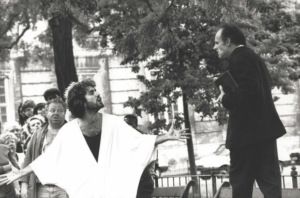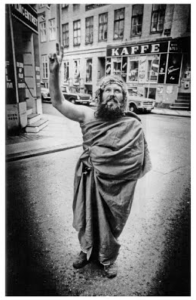Business & Education
Physician’s son, painter, performer, producer, provocateur, pornographer
This article is more than 8 years old.
Welcome to the colourful world of Jens Jørgen Thorsen, the filmmaker who nearly gave the world the Jesus porno

As one of the more controversial and enigmatic figures of the Danish art world of the 20th century, Jens Jørgen Thorsen was a man of endless distain for authority and censorship. The Nazi Occupation of Denmark, which hung over his early adolescence, provided a cornerstone to his unyielding passion for challenging the status quo and creating art that demanded individuals to engage.
Situational changes
Born in Copenhagen in 1932, Thorsen studied art history and architecture at the Royal Danish Academy of Fine Arts. In the years following his studies he found work as a painter, bricklayer, writing reviews for a newspaper and a museum assistant, and he even published a book, ‘Modernism in Danish Painting’.
It is unclear when exactly Thorsen started to become disillusioned with the mainstream art world of his time, but by the early 1960s he found himself a part of the growing situationist movement in Denmark.
While the beatniks in New York were hounding away at their typewriters, across the ocean Thorsen and other artists across the continent were more proactive – on the road to the anarchy that would briefly threaten the status quo in May 1968 in cities such as Paris.
Influenced by the ideas of the global modernist movement, the Scandinavian Situationists felt compelled to make art that reflected their own attitudes towards manufactured design and modern lifestyles.
SPUR’s new signing
After being rejected from the International Situationist Congress, a group of radical German artists calling themselves SPUR attracted the attention of Thorsen and he eventually joined their ranks.
SPUR then established itself in Drakabygget, a community that claimed to be populated by “poets, farmers, butchers, writers, dentists, doctors, artists, art-historians, truck drivers, transvestites, nuclear physicists, journalists, exhibitionists, hairdressers, sociologists, nymphomaniacs, and so forth”.
Provocative to the core, it seemed Thorsen had found his tribe. It was amongst these eccentric characters that Thorsen began to refine his art and more specifically what would become his defining medium: film and generating international controversy.
Crosses to bear
Thorsen was adamantly opposed to art that simply highlighted domesticity. It was not enough, Thorsen believed, to point out, as the modernists had, the consumer lifestyle that was coming to define Scandinavian Europe. He saw art as his duty, his cross to bear if you will, and method to wake the average person from their slumber in what he regarded as a sleepwalking world. “To turn a person into a spectator is to cut off his balls,” he observed, although his actions earned him the labels of ‘holy fool’ in the art world and ‘anarchist’ in the eyes of the public.
It is here, largely, that the story of the Jesus porno begins. In the years following his exile from the situationist movement, Thorsen commenced a campaign of outdoor actions. This included him walking through Odense accoutered in worn robes and bearing a heavy cross as well as organising a number of controversial film screenings.
With the intent of “liberating individuals from their spectatorship”, Thorsen helped to curate and orchestrate art that was shocking and subversive. In this task “pornography was Thorsen’s weapon of choice”. It was through pornography that Thorsen found a means of creating consistently disruptive and triggering art.
Immaculate erections
The prelude to the revelation of the Jesus porno may have come in the form of a painting on the wall of a Danish train station – one in which a crucified Jesus was depicted as having an erection.
After the release of his 1970 film ‘Stille dage i Clichy’ (‘Quiet Days in Clichy’), he released a statement about the next film he desired to produce. The statement was as follows: “Of course we could, in connection with Catholicism – which when it comes down to it lives off pornography – aim our guns at the pope, but I believe the best way to give the pope a forceful kick in the ass is to turn up the heat on Jesus. He has always interested me, although the use of Jesus as an authority figure repels me. In the film when Jesus rises up out of the grave, he’ll ball a farmer girl: a nice blonde girl. That by itself signifies in my opinion what Jesus ought to stand for, instead of standing for the repression of life and eroticism.”
Danish Christian organisations were quick to rally against Thorsen after his statements made headlines on television and in print. Almost immediately in response to his critics, Thorsen ran with the idea and the Jesus porno was born.
Outrage from every orifice
In 1973, Thorsen applied for funding for a film loosely titled ‘The Sex Life of Jesus’. He received 600,000 kroner from the Danish Film Institute (DFI), and public outcry swelled. Some 5,000 Christian demonstrators took to the streets of Copenhagen, while others wrote to politicians and newspapers to put a stop to the film. The Danish public at large was putting pressure on their politicians. They wanted the film gone.
Outside Denmark the country found itself in the hot seat. Having just abolished censorship, it became a cautionary tale for other Western democracies if they were to follow suit. The pope was at one time quoted as referring to Denmark as a “nest of sinfulness” and the Catholic journal, Neue Bildpost, demanded that the Danish queen put an end to the whole affair.
Victory in defeat
Only a few months after securing funding for his project, the DFI informed Thorsen that it had to rescind its offer. So before he had even begun filming, Thorsen found himself in heated legal battles with the DFI and the state. Over the next three years, ongoing anti-Thorsen demonstrations, court cases and political maneuvering proved to be the death of the project. Thorsen even attempted to bring his project to Sweden and Britain, but found his project barred in both countries. By 1976 the project was little more than vapour – Thorsen had tried everything, but the system had won out.
It was a bitter irony. In a way the film had done everything he ever wanted a work of art to do: provoke people into action, force them out of complacency and even engage the political theatre, but at the cost of the art itself.
This article draws heavily on (and uses translations provided in) ‘Jens Jørgen Thorsen: The Jesus Chronicles’, a chapter in the book ‘Scandinavian Blue: The Erotic Cinema of Sweden and Denmark in the 1960s and 1970s’ by Jack Stevenson, which is available to buy at Amazon.com and other online retailers.











































